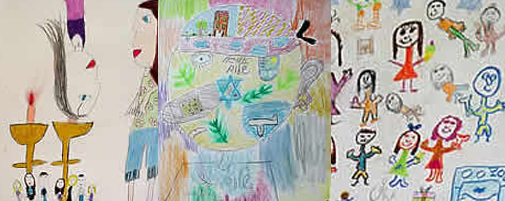
Exhibition created for the launch of the Adelaide Jewish Museum.
The students of Massada College were given a workshop on the paintings of Marc Chagall and were free to be inspired by his art and use elements from his paintings in their own works. Like Chagall, they were to use their own experiences, dreams and memories in their works. Many of the children’s art works have an untenable connection to Chagall, but nevertheless they have produced charming and imaginative art works.
Marc Chagall (1887-1985)
Chagall is internationally recognised as one of the most important Masters of the 20th Century. As one of the only Jewish artists to rise to such prominence, his art has particular significance for the students of Massada College. Chagall was born in Vitebsk, Russia. He was the oldest of eight children born to a poor Hassidic family. Life was hard for the Jews in Russia, who had to live in special areas and carry a pass. Jewish children were not allowed to go to State schools, however Chagall’s mother bribed a teacher to get him in to a State school because she recognized that he was particularly talented.
After school, Chagall studied art and saved money to go to Paris, an exciting place for artists at that time. He loved Paris, but longed forVitebsk, the village of his childhood, so it is not surprising that his paintings draw on images of Russia, Paris and his Judaism. Sometimes in his paintings there is a strange dreamlike space: Chagall built up his pictures from his dreams, imagination and memories (his inner world) and what he saw around him (the outer world). He spent four years in Paris, and then went to Berlin. From there he went back to Russia. The 1st World War had broken out and his fiance, Bella Rosenfeld, was waiting for him. They married in 1915. In his paintings she always seems to defy gravity, she floats or flies above the ground, or the sky opens up, and she walks on air above their hometown. Chagall was unable to leave Russia due to the outbreak of the Revolution.
Chagall and Bella had a daughter, Ida. He struggled to support his family as an artist because the new Russian government dictated how artists should paint. Chagall had his own ideas and refused to paint as he was told to – hence he left Russia again for Paris. There, Chagall again painted from memory: his people, his animals, and the houses of Vitebsk, but he also loved painting scenes from the Bible, the Eiffel Tower, Notre Dame and flowers and circus animals that he saw in Paris. His paintings are a visual narrative. It was suggested to the young artists that they draw a visual story of their own lives.
Chagall often paints the figure of the wandering Jew, who like himself, lives in exile. France was unsafe because of the 2nd World War looming, and Chagall and his family left for New York in 1941; they arrived the day before the German troops marched into Russia and destroyed Vitebsk. In America, three years later, Bella became ill and died. He turned his paintings around to face the wall; for some time he couldn’t paint; his love, and the person who inspired him, had died.
Some of his paintings seem surreal: clocks have wings, fish hold bunches of flowers, roosters have a human head, humans have a goat head; the magic of the circus ring, where fantasy is reality, where people walk on tightropes for a living, achieving the impossible, where trapeze artists do amazing tricks, people talk to animals, and animals perform for people – sometimes these images don’t make sense. Sometimes his world is not logical but symbolic, metaphors for things that mean something else. Some of the student’s work is inspired by this approach.
After the war, Chagall returned once again to France, and moved to the countryside. In 1950 he married Valentina Brodsky, who was also originally from Russia. Once again the light, the colours, and the smell of the flowers around him inspired him. He was to die in 1985 aged 98 – a prolific artist, famous worldwide for his paintings, ceramics, lithographs, etchings and stained glass windows.
Reference: Marc Chagall The Light of Origins written by Helene Smuts, Standard Bank Gallery Johannesburg
With thanks to Colin Murray and the teachers of Massada College and Victor Ades Memorial Kindergarten: Sue Brock, Jane Cohen, Mary Curnow, Joyce Hassan, Wendy Medley, Mike Woolford, Terry Aizen, Gail Di Lernia, Robyn Draper & Irina Sverdlov for helping to motivate and stimulate the young artists, allowing them to express their individuality and creativity. And the children for making beautiful visual stories of their lives and memories. Also thanks to Allen Bolaffi for sponsoring the materials for the art workshops, and for coming up with the concept initially.


Recent Comments